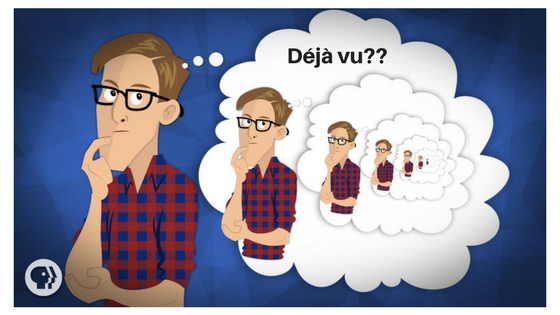One side of your brain is usually ‘in charge’ of a particular skill – for example, in most people, the left side of the brain deals with language. One explanation for déjà vu is that there is a split-second delay in transferring information from one side of the brain to the other. One side of the brain would then get the information twice – once directly, and once from the ‘in charge’ side. So the person would sense that the event had happened before.
Déjà vu is a French term that literally means “already seen” and has several variations, including déjà vécu, already experienced; déjà senti, already thought; and déjà visité, already visited. French scientist Emile Boirac, one of the first to study this strange phenomenon, gave the subject its name in 1876.
There are often references to déjà vu that aren’t true déjà vu. Researchers have their own definitions, but generally, déjà vu is described as the feeling that you’ve seen or experienced something before when you know you haven’t.
The most common misuse of the term déjà vu seems to be with precognitive experiences – experiences where someone gets a feeling that they know exactly what’s going to happen next, and it does. An important distinction is that déjà vu is experienced during an event, not before. Precognitive experiences, if they are real, show things that will happen in the future, not things that you’ve already experienced. (However, one theory about déjà vu deals with precognitive dreams that give us a “déjà vu feeling”
Hallucinations that are brought on by illness or drugs sometimes bring a heightened awareness and are confused with déjà vu. False memories that are brought on by schizophrenia can be confused with déjà vu as well. Unlike true déjà vu, which typically lasts from 10 to 30 seconds, these false memories or hallucinations can last much longer.
What causes déjà vu?
It is difficult to study déjà vu — the odd feeling you get when you sense you’ve already experienced something that you know you are doing for the first time — in the laboratory. This is mainly because the phenomenon is rare and difficult to reproduce. However, there are similarities between déjà vu and the more common experience of seeing a person who seems vaguely familiar to you, but whose name, how you know them, and where you previously met escape you.
Unlike déjà vu, scientists are able to test feelings of familiarity in the laboratory. One way they do this is by asking study participants to scan and quickly assess the familiarity of faces or places they have seen before and those that they are seeing for the first time. Such studies have helped researchers come to understand that familiarity and recollection are two different forms of memory that work together during recognition. While people experience the sense of familiarity rapidly, recollection, which requires the recovery of associations prompted by a critical cue, takes longer.
For instance, if you begin a casual conversation with that person you know you recognize but cannot quite place, you may start to uncover details that trigger memories revealing the person’s name and how you know them.
Functional MRI (fMRI) studies of people asked to judge the familiarity of faces and buildings have revealed that when people distinguish familiar from novel faces, changes in activity occur in an area of the temporal lobe called the perirhinal cortex. By contrast, an adjacent area called parahippocampal cortex is shows activity changes when people distinguish familiar buildings from those they are seeing for the first time.
Thus, déjà vu for a face may be the result of messages sent from the perirhinal cortex whereas déjà vu for a place may stem from messages relayed from the parahippocampal cortex. Notably, both of these regions send their information to the hippocampus, which supports recollection. So, the full experience of recollection may reflect a combining of converging signals from both perirhinal and parahippocampal areas to the hippocampus.
Fuente: bloke.ie
